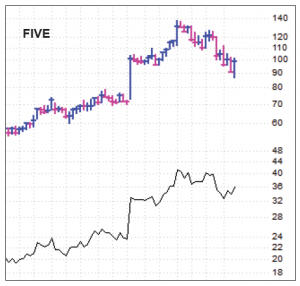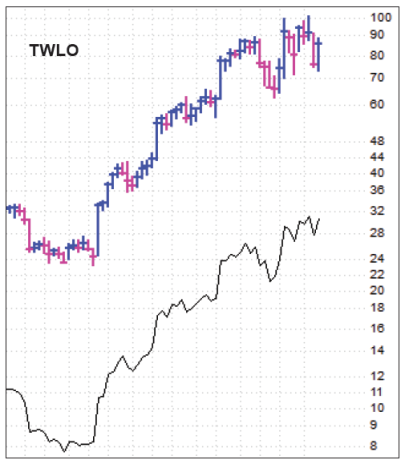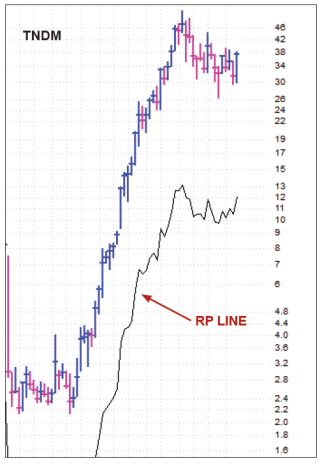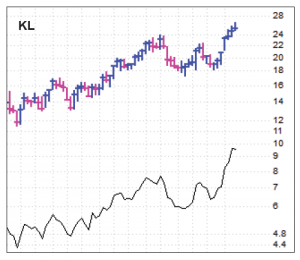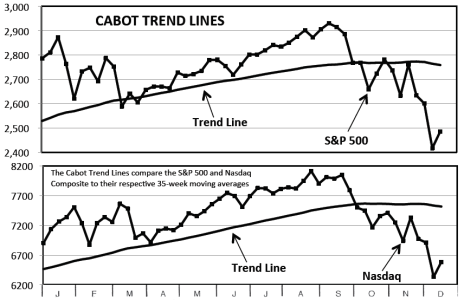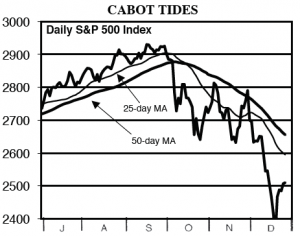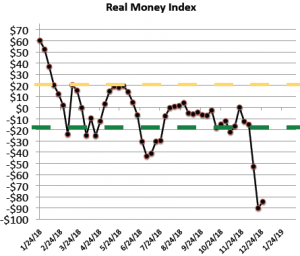Believe it or not, there are some legitimate reasons for hope as 2019 begins--the market’s December meltdown produced some historic extremes in sentiment and breadth, readings that have almost always occurred near the start of a bottoming process. If all goes well, the market will work in the weeks ahead to bang out a sustainable low, while the best stocks set up in pole position for the next advance.
Cabot Growth Investor 1410
[premium_html_toc post_id="167549"]
Reasons for Hope, but Not for Buying
The market has been a bummer during the past three months, with two massive downlegs (12% to 16% during the first three weeks of October, and then after some choppiness, another 16% to 18% during the first three weeks of December) driving most stocks and sectors into the ground.
But being that it’s a New Year, we do want to spread a little good news: There are reasons for hope that the market may be starting (or will soon start) a bottoming process. Numerous sentiment and oversold indicators reached levels during last month’s selloff that are seen once every decade or two, almost always in the vicinity of a sustainable low.
One figure in particular was jaw dropping: Both the NYSE and Nasdaq each saw more than 1,000 stocks hit new lows for three straight days heading into the December low. Compared to total issues traded, the percent of stocks hitting new lows was among the largest of all time! Moreover, the percent of stocks below their 200-day lines was the highest since 2011 and at levels associated with major bottoms.
In response, investors have turned sour. There are now more bearish advisors than bullish advisors, more than 40% of individuals have been bearish each of the past four weeks (first time since 2008) and our own Real Money Index shows that, in terms of actual money, the man-on-the-street is running for the exits.
Thus, there are legitimate reasons to believe we’ve seen a peak in downside momentum and that a bottoming process may be getting underway. If all goes well, the best stocks have already hit their lows, some new leadership will slowly form in the weeks ahead, the major indexes will have some successful retests of the low and, once we get a green light from our indicators, there will be big money to be made.
But, of course, we never advise buying based on ifs and maybes; right now, the best thing you can say about the market is that it’s held above its lows for a few days. Yet with the trends clearly down and most stocks in tatters, we’re remaining in our storm cellar, albeit with one eye outside to see if the clouds begin to part.
[highlight_box]WHAT TO DO NOW: Stick with your defensive stance and patiently wait for the selling pressure to dissipate. In the Model Portfolio, we were kicked out of Exact Sciences during the December meltdown, leaving us with two stocks and a cash position north of 80%. If a bottoming process begins, we could put a tiny bit of that cash to work, but the main focus remains staying safe while looking for potential new leaders to set up.[/highlight_box]
Model Portfolio Update
The Model Portfolio has bought a grand total of two stocks (Exact Sciences and Twilio) during the past four months and remains in a highly defensive stance, with more than 80% sitting on the sideline. And it doesn’t appear we’ll be going on any major buying spree in the near term, partly because of the overall state of the market (trends are clearly down), and partly because of the calendar—early January is known for wacky action as investors reposition themselves and (often) take any profits they have from the prior year.
That said, we’re also not ruling out a new addition (or maybe two half-sized positions) even before we get a green light from our Cabot Tides or Trend Lines. Why? Because of the many extremes seen during the December plunge—whether it’s broad market data or various sentiment measures, we saw a ton of decade-plus extremes that usually only occur near major bottoms.
As we explained on page 1, that doesn’t mean the market is ready to head higher from here, but it is growing more likely that a bottoming process has begun or will soon. If we see that play out—some successful retests, some positive divergences, some new leadership acting strong—we could take a stab at a stock or two.
As we often write, it’s always good to have a plan so that you’ll be ready to pounce if the opportunity arises. Yet when it comes to taking action, you still need to see the whites of the bulls’ eyes; at this point, the best we can say is that the market has stopped going down for the past few trading days, which isn’t enough for us to put new money to work. Thus, we’re sitting tight in this week’s issue.
The good news is, if we have seen the peak in downside momentum for the market, the best stocks may have already put in their lows. We still think both FIVE and TWLO can help lead the next advance, and we continue to think that, given the severity of this decline, a batch of new leaders can produce big gains once we get a firm bottom in place. Until then, patience.
Current Recommendations
SOLD—Exact Sciences (EXAS 62)—We were forced to sell EXAS when it tripped our loss limit during the December mini-crash in the market. But even beyond that, the resilience that was seen from the stock in October and November has dissipated; shares plunged below their 200-day line and below their October/November lows on big volume two weeks ago, and even after the recent bounce, are still near those prior lows. Obviously, it’s not the worst chart out there, and with Pfizer on board and with an economically independent product in Cologuard, growth should remain robust; it’s certainly worth watching and seeing if the stock can kick back into gear. (The company is presenting at an industry conference on January 8, so we’ll see if anything new is said or any update on Pfizer’s efforts is revealed.) At this point, we’d probably want to see a push back into the mid-70s to get interested in EXAS again. If you still own shares and want to give them a chance from here, that’s fine, but having sold, we currently see a handful of other stocks with enticing growth stories and charts that look firmer.
HOLD—Five Below (FIVE 104)—We held onto our position in FIVE even though the stock cracked support in the mid-90s a couple of weeks ago, mostly because (a) we still had a big profit and have taken partial profits a couple of times, and (b) the market was flashing so many oversold readings that we thought the odds favored a bounce (at least) for the stock and the market. So far, that’s proven to be the right move, and we’re pleased to see buyers jump back into the stock when the pressure came off the general market for a few days. We’re not huge on lagging economic indicators, which tell you about the past and not the future, but there was one piece of evidence worth noting—a weekly update on industry-wide same-store sales at around 9,000 stores from large outfits (put out by a company called Redbook) has shown jaw-dropping growth in recent weeks, with year-over-year same-store sales up 9.3% for the last week of the year, the fastest growth rate in more than 10 years! (December as a whole saw sales up more than 7% from a year ago, so this wasn’t a one-week blip.) That doesn’t directly reflect on Five Below, of course (in fact, the company has posted positive same-store sales growth every year going back more than a decade), but on the surface it’s a sign that the holiday shopping season was likely a good one for the industry. As for the stock, the recent bounce could meet some resistance in the 105 to 110 range, but a decisive push above that (and some further evidence of a bottoming process in the overall market) could have us restoring our Buy rating. For now, though, we advise sitting tight.
HOLD—Twilio (TWLO 81)—Every December some publishers reach out for our top pick of the following year, and for 2019, my pick is Twilio, for many of the reasons that have been written about before: The company looks like an emerging blue chip, the type of name we think will see its fund sponsorship increase dramatically over time (443 mutual funds owned shares at the end of September, but we wouldn’t be shocked to see that figure up over 1,000 within two or three years) as the firm’s communications platform continues to gain traction both among new customers (client count was up 32% in Q3) and current users (revenue per client leapt 27% in Q3!), driving revenues higher and pushing earnings further into the black (the bottom line has been positive each of the past two quarters). The thing we most enthuse about here from a fundamental perspective is the pervasiveness of its solution; most companies that sell productivity-enhancing software to other businesses target a certain segment (Fortune 500, a specific industry or two, etc.), but Twilio is being used by everything from giant, worldwide outfits to us! (We use it for some text message alerts and to route certain phone calls.) Now, for full disclosure, our top pick prediction is obviously a guess; last year’s pick was Five Below, which worked well, but if Twilio’s outlook darkens or if the chart implodes, we’ll cut our loss and move on. But so far, even including today’s sharp retreat, the evidence continues to support the notion that TWLO wants to get going if the market can bottom out—even at its December nadir, the stock’s low (73) was above the November and October lows (72, 63), and it quickly snapped back above its 50-day line. A drop back below its recent low would mark a change in character and cause us to move on, but right now, we’re holding on to our shares.
Watch List
Alteryx (AYX 57): Few investors have heard of Alteryx, but it’s one of a handful of potential new leaders in the advanced analytics sector, with software that allows data scientists and analysts to put together and alter analytic models based on any form of data the company has. The stock has been choppy, but repeatedly rebounds after it gets hit—a good indication that institutions are accumulating shares.
Ciena (CIEN 33): CIEN continues to show outstanding relative strength; the stock is two points higher than it was when the market downturn began, and is just three points off multi-year highs. Both CIEN and XLNX (see below) look like leaders in the newer theme of 5G and webscale infrastructure; we’d like to own one of them once the market gets moving.
MongoDB (MDB 76): Our biggest rub with MDB is its volatility—the stock is moving around about 7% per day (from high to low) in recent weeks, which makes it nearly impossible to handle. That said, we love the story (new database platform that all kinds of firms are using), so we’ll see if the stock can come under control once the market starts to behave itself.
Okta (OKTA 60): OKTA is the one stock we sold during the past few months that we wish we still held—everything from the stock’s bullish reaction to earnings, to its significantly higher low last month, to its leadership position in the identity access management sector points toward higher prices down the road. We also like the fact that the stock only ran seven months from its first breakout (last February), so it’s far from obvious or over-owned.
PayPal (PYPL 82): PYPL and WDAY (see below) are two of the best positioned names to be liquid leaders of the next advance. That doesn’t mean they’re going to skyrocket, but they could be the ones big investors flock to going forward due to their combination of solid liquidity and excellent and dependable growth. PayPal’s story remains solid and the chart remains relatively resilient—earnings, out later this month, will likely tell the tale.
Planet Fitness (PLNT 53): PLNT has a prolonged run, which was one reason we didn’t get involved with it in recent months, but the fact that it’s held up so well since October is a sign there’s more upside to go. It’s not the fastest growing outfit (15% to 20% cash flow per year) but its business dances to its own drummer, so that growth should continue for a long time to come.
ProShares Ultra S&P 500 Fund (SSO 88): Looking out six to 12 months, the pieces are in place (big prior decline, hugely negative sentiment, historic oversold readings) for a good-sized move from the market. If we get a solid bottoming process and some decisive buy signals, we’ll likely be adding a leveraged long fund, be it SSO or ones that follow the Nasdaq 100 (QLD) or Russell 2000 (UWM).
Workday (WDAY 154): WDAY never dipped below its 50-day line during the December meltdown and has actually bounced back above its 25-day line, a very rare show of strength.
Xilinx (XLNX 84): The projections for XLNX aren’t all that impressive (earnings forecast to rise single digits this year), but we’re having a hard time believing those numbers given its accelerating revenue growth, estimate-beating Q3 report and the stock’s action, including its moonshot in November following earnings. It’s definitely worth keeping an eye on.
Zscaler (ZS 39): Between ZS and OKTA, both of which are security plays, we lean slightly toward OKTA because of its greater trading volume and, honestly, we understand the business a bit better. But we remain intrigued by Zscaler given its newness (public in March of this year) and what seems like a growing consensus that the firm could see its sales rise five- to 10-fold over the next many years if management pulls the right levers.
Other Stocks of Interest
The stocks below may not be followed in Cabot Growth Investor on a regular basis. They’re intended to present you with ideas for additional investment beyond the Model Portfolio. For our current ratings on these stocks, see Updates on Other Stocks of Interest on the subscriber website or email mike@cabotwealth.com.
Tandem Diabetes (TNDM 32)—We’re still keeping a distant eye on former holding Dexcom (DXCM), whose G6 continuous glucose monitor should continue to drive growth for at least a couple of years. Tandem Diabetes is another player in the diabetes field, but its claim to fame is its insulin pump, dubbed t:slim X2, which is actually integrated with Dexcom’s system and has many of the bells and whistles (much smaller and lighter than other pumps, touchscreen, remote update capability, predictive low glucose technology, rechargeable battery) that customers love. About 90% of the firm’s customers are Type 1, and half converted from daily injections, with the other half switching from a different pump, but that’s just scratching the surface—there are north of three million potential users in the U.S. alone, with another three million overseas, many of which have never used pumps before. (The firm just launched internationally in August and estimates it has around 70,000 U.S. users.) Revenues rose 71% in Q3 and analysts see the top line expanding 33% in 2019 (likely conservative), while management sees cash flow breakeven in the second half of the year. The stock had an enormous run last year, but encouragingly, is building a normal-looking launching pad in recent months as volume has dried up. It’s worth watching.
TAL Education (TAL 25)—Chinese stocks are about the most hated area of the market, but we’re actually seeing a few names with excellent growth outlooks show some relative strength. One is TAL, which is one of the top dogs in the for-profit education business in China, a very large, important and economically independent industry in that country. Earnings growth has been crimped a bit by heavy investments, but those investments are clearly working—in the quarter ending August 31, TAL’s revenues rose 54%, student enrollment boomed 120% (to 4.9 million), the firm’s network expanded to 649 learning centers in 43 cities and it also has a thriving online offering. Analysts see that growth continuing, and earnings growth should kick back into gear in a few months, too. The stock collapsed 56% in just four months (!), but bottomed in early October, spiked on huge volume later that month and has held up very well in recent weeks. It’s not yet in an uptrend, but the worst may have passed, and once the market turns healthy TAL looks like it wants to head up. Earnings are due out January 24.
Kirkland Lake Gold (KL 27)—Full disclosure: We’re probably not going to be buying any gold stocks in the Model Portfolio, but if we were, Kirkland Lake is at the top of the list, both because of the stock’s action (first gold stock to punch out to new highs, including a persistent advance in recent weeks) and because it has a real growth story. The firm operates five total mines in Canada and Australia, though it gets most of its output from two mines (Macassa mine in Toronto and Fosterville mine in Victoria, Australia) that produce among the highest-quality gold in the world. Thanks mostly to organic growth (including a nice pickup from Fosterville, whose Swan Zone looks very unique and lucrative), output should total around 650,000 ounces this year, and management has released a very bullish three-year outlook, with 10% to 15% production growth annually through 2021. Exploration costs are expected to decline after next year, too. Throw in sinking costs on a per-ounce basis thanks to efficiencies and Kirkland is already seeing earnings and cash flow grow nicely, and the recent rally in gold prices should accelerate that trend in the quarters ahead. KL has been outperforming for a while, and after building a tidy base from August through mid-November, has turned very strong. If you want in, you could start small here or (preferably) look for dips of a couple of points.
One Simple Tool for the Sell Side
Usually the market is sleepy in the second half of December, which allows us to get a jump on some post-op review from the year that was. 2018 kept us much busier given the environment, but we still started the process of looking back on the good, bad and ugly of our actions.
In the early stages of our review, one thing that popped up was a pattern that we originally noticed a few years back and again flashed a couple of times last year. This selling tool is very simple, yet it often occurs right after an all-time high, giving you a signal that your winner has topped out.
All this selling tool involves is that (a) the stock’s had a good-sized and prolonged run of at least a few months if not a year or more, and (b) soon after a new high, the stock suffers at least three or four (sometimes more) huge-volume declines in a row, usually taking the stock below its 50-day line in the process. Initially, such selling seems like a short-term signal (that the immediate advance has ended), but we’ve found it frequently leads to longer-term declines, too.
(We don’t have an official name for it yet, but are thinking about calling it the Switch signal, telling you the stock has suddenly switched from being accumulated to distributed.)
We first noticed this back in 2012 when leader Chipotle Mexican Grill (CMG), which had been advancing smoothly for months, suffered four straight big-volume declines right after its all-time high, dipping below its 50-day line on the fourth day. The stock didn’t cascade right away, but it was met with tough resistance for the next two months before imploding, falling nearly 50% from its peak in just six months.
Then, early last year, we saw it again in Universal Display (OLED), which was a good winner for us and looked great last January, breaking out to new highs on good volume. But the stock’s action then suddenly changed—OLED suffered four straight days of huge-volume selling right off the top, taking the stock below its 50-day line. The story still seemed OK and the stock looked “oversold,” but that was the top, as shares imploded a total of 58% in three and a half months!
Ligand Pharmaceuticals (LGND) was another example from last year, though it followed a slightly different script—shares fell six days in a row off their high, but volume, while above average, wasn’t huge. (Even so, we took partial profits at the time because of the market’s action.) But the selling never stopped, with volume exploding higher while LGND dropped like a rock. Similar to the other examples, the stock looked oversold and the story seemed fine (in fact, the story still seems fine), but the massive selling volume soon after the top following a solid advance was a sign the trend had changed; LGND fell 58% from its high in less than three months and continues to languish near its lows.
It’s not just stocks that we’ve had in the Model Portfolio, either. Check out Align Technology (ALGN), which was a great winner from 2016 through September of last year. But the switch from uptrend to downtrend occurred suddenly, and again was marked by five straight days of huge-volume declines right off the top, with shares easily slicing their 50-day line. ALGN was cut in half less than one month after peaking and actually hit new lows today.
That said, no chart pattern is foolproof, and there have been times when a Switch signal led to OK performance; Shopify (SHOP) seemed to form one in March, and while the stock hasn’t done much since then, it did rally for a couple of months afterwards. But more often than not, a big run (especially if it’s a smooth advance that creates some “pent-up” selling pressure) followed by a sudden wave of distribution can mark an intermediate- to longer-term peak.
Of course, given that the market has already fallen apart and we’re sitting on a huge cash position, our next major move will be on the buy side; the main focus is on identifying when the market’s trend has turned up and which (likely newer) names will be leaders.
But this simple pattern has shown itself often enough in our studies to be included in our toolkit—we think it will help us get out of at least some shares of a big winner relatively close to its peak.
Cabot Market Timing Indicators
The post-Christmas bounce has been a relief following the three-week mini-crash to start December. It’s possible this bounce develops some power given the intensity of the recent selling, but given the fact both major trends remain down, the onus remains squarely on the bulls to step up to the plate.
Cabot Trend Lines: Bearish
Our Cabot Trend Lines remain on the bearish side of the fence despite the market’s latest bounce. At the end of last week, both the S&P 500 (by a huge 9.9%) and the Nasdaq (by 12.4%!) were sitting well below their respective 35-week moving averages. Ideally, last week’s low begins a bottoming process, but even if that’s the case it’s going to take a while for the longer-term trend to reverse up.
Cabot Tides: Bearish
Our Cabot Tides are also clearly bearish, with all five major indexes we track (including the S&P 500, daily chart shown here) still meaningfully below their lower (25-day) moving averages. At best, it’ll take another couple of weeks for the intermediate-term trend to turn up even if the indexes continue to push higher. With both major trends down, you should stick with a defensive stance.
Cabot Real Money Index: Bullish
Our Real Money Index is still at extreme levels, with $84 billion gushing out of equity mutual funds and ETFs during the past five weeks. Combined with some other historic oversold metrics (see page 1), this indicator adds to the evidence that the market may have hit (or will soon hit) a workable low and can begin a bottoming process. It’s no reason to plow in, but it’s good to see so many investors throw in the towel.
[premium_html_footer]
Send questions or comments to mike@cabotwealth.com.
Cabot Growth Investor • 176 North Street, Post Office Box 2049, Salem, MA 01970 • www.cabotwealth.com
All Cabot Growth Investor’s buy and sell recommendations are made in issues or updates and posted on the Cabot subscribers’ website. Sell recommendations may also be sent to subscribers as special bulletins via email and the recorded telephone hotline. To calculate the performance of the portfolio, Cabot “buys” and “sells” at the midpoint of the high and low prices of the stock on the day following the recommendation. Cabot’s policy is to sell any stock that shows a loss of 20% in a bull market (15% in a bear market) from our original buy price, calculated using the current closing (not intra-day) price. Subscribers should apply loss limits based on their own personal purchase prices.
Charts show both the stock’s recent trading history and its relative performance (RP) line, which shows you how the stock is performing relative to the S&P 500, a broad-based index. In the ideal case, the stock and its RP line advance in unison. Both tools are key in determining whether to hold or sell.
THE NEXT CABOT GROWTH INVESTOR WILL BE PUBLISHED JANUARY 16, 2019
We appreciate your feedback on this issue. Follow the link below to complete our subscriber satisfaction survey: Go to: www.surveymonkey.com/marketlettersurvey
Neither Cabot Wealth Network nor our employees are compensated by the companies we recommend. Sources of information are believed to be reliable, but are in no way guaranteed to be complete or without error. Recommendations, opinions or suggestions are given with the understanding that subscribers acting on the information assume all risks. © Cabot Wealth Network. Copying and/or electronic transmission of this report is a violation of U.S. copyright law. For the protection of our subscribers, if copyright laws are violated, the subscription will be terminated. To subscribe or for information on our privacy policy, call 978-745-5532, visit www.cabotwealth.com or write to support@cabotwealth.com.
[/premium_html_footer]




